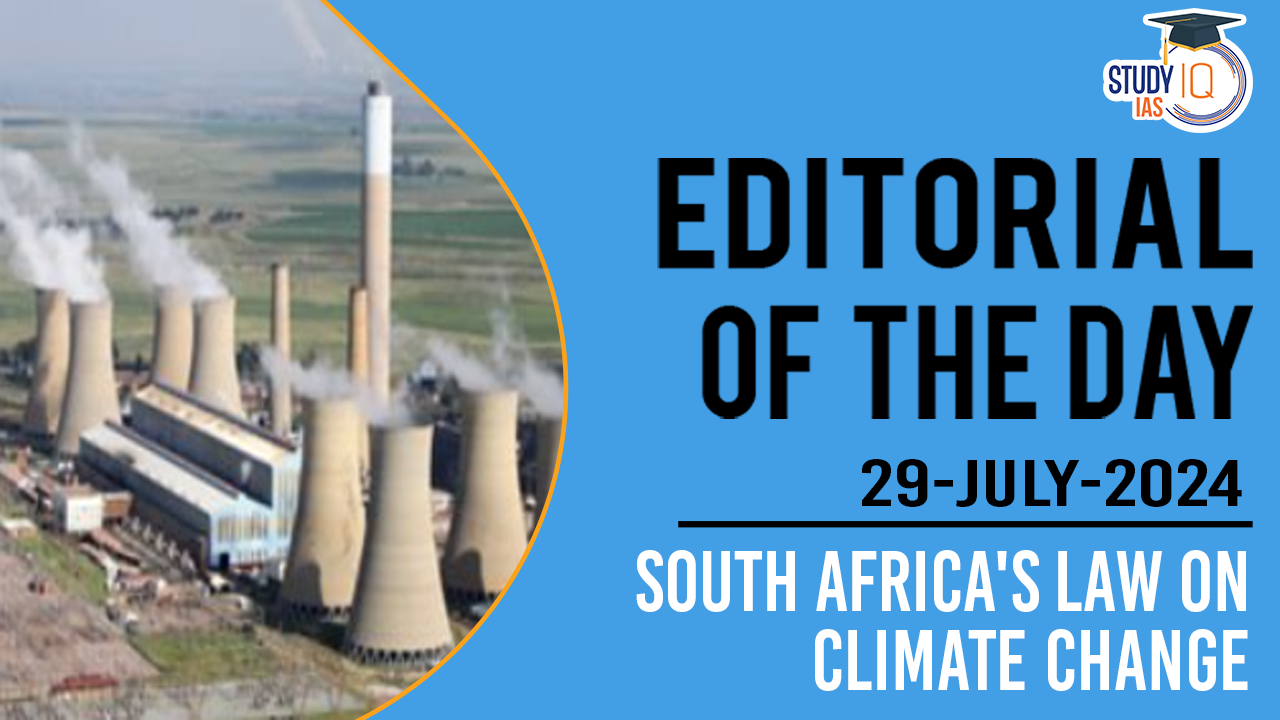Table of Contents
Context
- South Africa’s President, Cyril Ramaphosa, has signed legislation that imposes mandatory curbs on emissions from large, fossil-fuel-heavy industries and requires climate-adaptation plans from towns and villages.
- This law aims to help South Africa meet its emissions reduction commitments under the Paris Agreement.
Background
- The Climate Change Bill was approved by South Africa’s National Assembly in November.
- South Africa is highly reliant on coal for electricity generation and is among the world’s top 15 greenhouse gas emitters.
- In 2017, South Africa’s net emissions were estimated at 512 million tonnes of carbon dioxide equivalent (Mt CO2e), up 14% from 2000.
- By 2022, emissions had fallen to 405 Mt CO2e, a 3% decrease from 2021, according to Statista, though the comparability of these figures and the impact of the COVID-19 pandemic on emissions is unclear.
- The energy sector accounts for roughly 80% of gross emissions, with energy industries contributing ~60% and transport ~12%.
- As an economy dependent on agriculture and tourism, South Africa has faced increased pressure from Western nations to transition away from fossil fuels.
Steps Taken by South Africa
- Nationally Determined Contributions (NDC):
- South Africa submitted its first NDC in 2016 and an updated NDC in 2021.
- The updated NDC commits to a 31% reduction and sets a target for GHG emissions at 398-510 MtCO2e by 2025 and 350-420 MtCO2e by 2030.
- Approach to ‘Just Transition’:
- Focuses on sustainable job transitions away from fossil-fuel-dependent industries.
- Targets sectors such as agriculture, forestry, land use, energy, industrial processes, product use, and waste.
- Estimated funding needs of $8 billion per year by 2030.
- Aims for ‘net zero emissions’ by 2050 as per the Low-Emission Development Strategy submitted in 2020.
- Presidential Climate Commission’s Just Transition Framework (2022):
- Aims to inform policy making at the intersection of climate and development to enable significant, just transformational shifts.
Comparison with India
- India lacks comprehensive climate change legislation.
- Council on Climate Change Bill:
- A Private Member’s Bill moved by Priyanka Chaturvedi in 2022 proposed establishing a Council chaired by the Prime Minister to advise the Union government on climate change matters.
- No significant progress on this bill so far.
- Existing Laws:
- Climate change is addressed in multiple Acts, including the Environmental Protection Act, Forest Conservation Act, Energy Conservation Act, and Water (Prevention and Control of Pollution) Act.
Adequacy of Current Measures
- In April, the Supreme Court ruled that citizens have a “right against the adverse effects of climate change” and highlighted the absence of comprehensive climate change legislation.
- The Court emphasised that the impact of climate change impedes citizens’ rights to liberty, life, and equality, necessitating explicit legal links.
- Emissions Reduction Achievements:
- Before the UN Conference of Parties in Dubai, India reported a 33% reduction in energy emissions intensity from 2005-2019, achieving the target 11 years early.
- India’s updated NDC commits to reducing emissions intensity by 45% by 2030.
- Emission intensity measures GHG emissions per unit of GDP, differing from absolute emissions.
- India aims for 50% of its electricity to come from non-fossil fuel sources by 2030.


 State of State Finances Report 2025: Key...
State of State Finances Report 2025: Key...
 India AI Governance Guidelines 2025: Ena...
India AI Governance Guidelines 2025: Ena...
 GPS Spoofing: Meaning, Working, Types, I...
GPS Spoofing: Meaning, Working, Types, I...
























